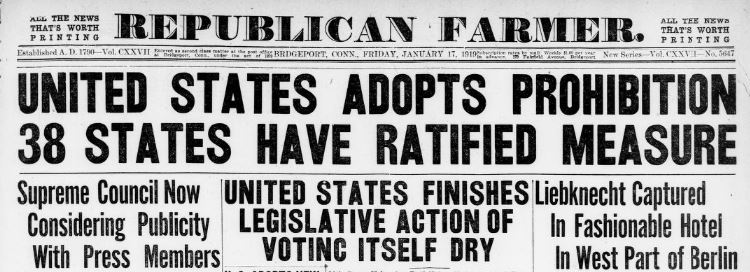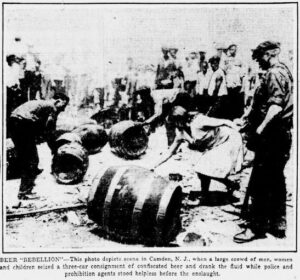by Erin Shapland
The newspaper articles you find in your research may contain offensive and harmful language and content. The Connecticut Digital Newspaper Project digitizes historical newspapers to preserve the historical record, and as a result, these newspapers reflect outdated, biased, and offensive views. Through resources such as our topic guides, CDNP seeks to contextualize the historical content you might find while searching the newspapers digitized through our project.
Introduction
Following the Revolutionary War, the prevalence of drinking in the United States rose to unprecedented highs. In Connecticut, unemployment was up due to excessively farmed land, the population was dwindling as laborers left the state to find work elsewhere, and out-of-wedlock births were at an all-time high. Alcohol was part of religious services, recreation, and medicine, and among men, was typically consumed throughout the day. At the so-called height of American drinking, in 1830, the average American adult (those 15 years of age and older) was drinking 7.3 gallons of 80 proof liquor per year.
In the early 19th century, a cultural trend toward temperance and abolitionism swept through the nation. In Connecticut, prominent religious leaders like Lyman Beecher of Litchfield observed the social problems stemming from excessive drinking among their congregations and began preaching on the importance of abstaining from alcohol. At the moral core of this trend was the belief that without access to alcohol, the American family and economy would be stronger, and Americans would be physically healthier. By the late 19th century, organizations like the Woman’s Christian Temperance Union and the Anti-Saloon League were founded, and the popular push for temperance laws was underway. With the exception of the early Suffrage movement, it was in the Temperance Movement that American women began to participate actively in political life for the first time. At the time, women rarely worked outside the home, had not achieved suffrage, and were otherwise inactive in public life. Because of their reliance on their husbands, and because of their husbands’ erratic behavior resulting from excessive drinking, they were likeliest to be financially and physically affected by the drinking culture among American men.
At the outset of the first World War, Anti-Saloon League lobbyists saw an opportunity in increasingly common food rationing propaganda. American troops needed grain overseas, anti-German sentiment was on the rise, and Temperance was widely popular, so outlawing the manufacture of beer was an easy sell for conservation and social betterment. The Wartime Prohibition Act was passed on November 18, 1918, and the Prohibition Amendment, the 18th, which outlawed the manufacture and sale of alcohol federally, was ratified on January 16, 1919.
Connecticut and Rhode Island were the only states to reject Prohibition altogether. Connecticut’s State Senate voted against ratification by a vote of 20-14, and throughout the Prohibition era, enforcement of the amendment was sparse in the state. Prominent bootleggers in Connecticut included Nellie Green and August Campbell Strausholm, both of whom ran their operations from coastal Connecticut inns. Access to the water made bootlegging simple, as “Rum Runner” ships would park along “rum row” in international waters (three miles off the coast) and sell cases of liquor often retrieved from the Bahamas. Organized crime became more prevalent than ever before in the United States during this time, as the logistics of distributing massive quantities of illegal liquor required more planning and personnel than other kinds of illegal activity.
The stark rise in crime and civil unrest that stemmed from the illegal liquor trade cast a shadow on the good intentions of the Temperance Movement throughout the 1920s. Even in the early days of Prohibition, limited enforcement and the prevalence of violent crime swung public opinion away from the Progressive ideal that liquor bans would drive out drinking, and toward interest in repealing the 18th. In the early days of the Great Depression, a time when unemployment reached a high of 24.9%, the federal government struggled to raise tax revenue for social assistance programs and taxation of legal liquor sales began to look like a lifeboat. In March 1933, Franklin Delano Roosevelt signed the Cullen-Harrison Act, which legalized the sale of beer and wine with low alcohol content (3.2% ABW). In December 1933, the 21st Amendment was ratified by a 36th state (Utah) and officially added to the Constitution, ending the Prohibition era.
How to Search
Open the Library of Congress Chronicling America collection, click on the “Advanced Search Tab, and select “Connecticut” in the “Select State(s)” box. Enter the search terms below in the boxes labeled “with all of the words” or “with the phrase.” A proximity search is also available by using the box labeled “with the words:…within 5 words of each other” – this will ensure your search terms are located close together on the page. Once you’ve entered all search information, click “Search.” Filter results by date to find articles published within the Prohibition era by using “Advanced Search” and selecting a date range from 1919 to 1933.
Users may need to search for, or may encounter, biased and offensive language when searching these historical newspapers for information about Prohibition. Historical newspapers reflect attitudes held at the time they were published, and we at CDNP seek to acknowledge that these terms are offensive and potentially harmful while maintaining our commitment to preserving historical newspapers and providing public access to their content.
Drinking Before Prohibition:
- Drink Habit
- Saloon
The Temperance Movement:
- Wets, Drys
- Prohibition
- Dry Law/Dry Bill
- Temperance
Organized Crime:
- Rum Runner/Rum Chaser
- Bootlegger/Bootlegging
- Gang/Gangster
- Racketeer/Racketeering
Drinking Under the Radar (search between 1920 and 1932):
- Coast Guard
- Speakeasy
- Alcohol, Rum, Whisky/Whiskey, Scotch, Gin, Beer, Wine
Legislation:
- Volstead Act/Volstead Law
- Cullen-Harrison Act
- Prohibition, Dry Law, Dry Bill
Sample Search Results
“Why I Drink Beer,” Bridgeport Evening Farmer (Bridgeport, CT), April 3, 1917, page 12. Chronicling America: Historic American Newspapers. Lib. Of Congress. <https://chroniclingamerica.loc.gov/lccn/sn84022472/1917-04-03/ed-1/seq-12/>
“License or Prohibition,” Bridgeport Evening Farmer (Bridgeport, CT), November 1, 1917, page 7. Chronicling America: Historic American Newspapers. Lib. of Congress. <https://chroniclingamerica.loc.gov/lccn/sn84022472/1917-11-01/ed-1/seq-7/>
“State Senate Declines to Ratify Prohibition,” Norwich Bulletin (Norwich, Conn.), February 5, 1919, page 1. Chronicling America: Historic American Newspapers. Lib. of Congress. <https://chroniclingamerica.loc.gov/lccn/sn82014086/1919-02-05/ed-1/seq-1/>
“Sale of Real Beer is Now Authorized,” New Britain Herald (New Britain, CT), October 25, 1921, page 17. Chronicling America: Historic American Newspapers. Lib. of Congress. <https://chroniclingamerica.loc.gov/lccn/sn82014519/1921-10-25/ed-1/seq-17/>
“Bird Brings Cryptic Message,” New Britain Herald (New Britain, CT), December 20, 1929, page 36. Chronicling America: Historic American Newspapers. Lib. of Congress. <https://chroniclingamerica.loc.gov/lccn/sn82014519/1929-12-20/ed-1/seq-36/>
“Survey Shows Prohibition Major Issue Throughout Nation Today,” New Britain Herald (New Britain, CT), March 20, 1930, page 12. Chronicling America: Historic American Newspapers. Lib. of Congress. <https://chroniclingamerica.loc.gov/lccn/sn82014519/1930-03-20/ed-1/seq-12/>
“Beer ‘Rebellion’,” New Britain Herald (New Britain, CT), July 15, 1930, page 18. Chronicling America: Historic American Newspapers. Lib. of Congress. <https://chroniclingamerica.loc.gov/lccn/sn82014519/1930-07-15/ed-1/seq-18/>
“Public Opinion Much Against Prohibition,” The Waterbury Democrat (Waterbury, CT), January 29, 1932, page 1. Chronicling America: Historic American Newspapers. Lib. of Congress. <https://chroniclingamerica.loc.gov/lccn/sn82014085/1932-01-29/ed-1/seq-1/>
“Send This Telegram to Repeal,” The Waterbury Democrat (Waterbury, CT), June 27, 1932, page 7. Chronicling America: Historic American Newspapers. Lib. of Congress. <https://chroniclingamerica.loc.gov/lccn/sn82014085/1932-06-27/ed-1/seq-7/>
“Prohibition at the Crossroads,” The Waterbury Democrat (Waterbury, CT), July 12, 1932, page 10. Chronicling America: Historic American Newspapers. Lib. of Congress. <https://chroniclingamerica.loc.gov/lccn/sn82014085/1932-07-12/ed-1/seq-10/>
“Thirteen Years of Dryness Has Been Vanquished,” The Waterbury Democrat. [volume] (Waterbury, Conn.), April 7, 1933, page 1. Chronicling America: Historic American Newspapers. Lib. of Congress. <https://chroniclingamerica.loc.gov/lccn/sn82014085/1933-04-07/ed-1/seq-1/>
Bibliography
“Anti-Saloon League Collection.” Westerville Public Library, https://westervillelibrary.org/antisaloon/.
Boyd, Jennifer and Sara Conner, directors. Prohibition: Connecticut Goes Dry | CT Public . Prohibition: Connecticut Goes Dry, CT Public, 25 July 2012, https://www.youtube.com/watch?v=0oZn6jFeypw. Accessed 18 Apr. 2023.
“Dillon v. Gloss, Deputy Collector.” Legal Information Institute, Cornell Law School, https://www.law.cornell.edu/supremecourt/text/256/368.
“Great Depression Facts.” FDR Presidential Library & Museum, https://www.fdrlibrary.org/great-depression-facts.
“Hawke v. Smith, Secretary of State of Ohio.” Legal Information Institute, Cornell Law School, https://www.law.cornell.edu/supremecourt/text/253/221.
Lerner, Michael A. “Going Dry: The Coming of Prohibition.” The National Endowment for the Humanities, https://www.neh.gov/humanities/2011/septemberoctober/feature/going-dry.
“Published Pennsylvania Archives.” Pennsylvania Historical & Museum Commission, https://www.phmc.pa.gov/Archives/Research-Online/Pages/Published-PA-Archives.aspx.
“The Senate Overrides the President’s Veto of the Volstead Act.” United States Senate, 12 Dec. 2019, https://www.senate.gov/artandhistory/history/minute/Volstead_Act.htm.
Volstead Act. Pub. L. 66–66. 28 Oct. 1919. 41 Stat. 305–323, ch. 85.
“World Women’s Christian Temperance Union Beginnings.” WWCTU, http://www.wwctu.org/pages/history.html.



